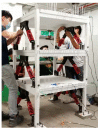Reliability Analysis of Reinforced Concrete Structure with Shock Absorber Damper under Pseudo-Dynamic Loads
- PMID: 35408021
- PMCID: PMC9000473
- DOI: 10.3390/ma15072688
Reliability Analysis of Reinforced Concrete Structure with Shock Absorber Damper under Pseudo-Dynamic Loads
Abstract
Past historical earthquake events from neighbouring countries have been proven to be disastrous. Building in the aftermath of an earthquake may reduce structural reliability, posing risk upon re-occupation of the building. Shock absorber viscous dampers were installed on a specific structure storey that could reduce the spectral acceleration and storey-drift caused by an earthquake. The research object is a low-rise, three-storey, reinforced concrete (RC) structure. This study aims to identify the dynamic response of the scaled RC structure with and without attached dampers and performs structural reliability of the tested model under the excitation of Peak Ground Acceleration (PGA) of 0.1 g to 1.0 g with a unidirectional shaking table. APIDO viscous dampers were installed parallel to the movement direction of the dynamic load test. The findings show the scaled model with attached viscous dampers reduces spectral acceleration and storey drift by 9.66% and 4.85%, respectively. Findings also show the change of the structural behaviour from single curvature to double curvature due to the increase in seismic structural resistance by viscous dampers. The breakthrough of this research shows that structural reliability analysis performed by the Weibull distribution function has a base shear capacity increment of 1.29% and 6.90% in seismic performance level Life Safety (LS) and Collapse Prevention (CP), respectively. The novelty of this case study building with dampers managed to increase the building's base shear and roof shear capacity by 6.90% and 16% compared to the building without dampers under dynamic load excitation.
Keywords: damper; dynamic response; reliability analysis; scaled model; seismic.
Conflict of interest statement
The authors declare no conflict of interest.
Figures
















References
-
- Li M., McNamara A.K. Evolving morphology of crustal accumulations in Earth’′s lowermost mantle. Earth Planet. Sci. Lett. 2021;577:117265. doi: 10.1016/j.epsl.2021.117265. - DOI
-
- Ishikawa T., Yoshimib M., Shoji K.I., Yokohama S. Reconnaissance report on geotechnical damage caused by 2018 Hokkaido Eastern Iburi earthquake with JMA seismic intensity 7. Soils Found. 2021;61:1151–1171. doi: 10.1016/j.sandf.2021.06.006. - DOI
-
- Kanamori H., Brodsky E. The physics of earthquakes. Rep. Prog. Phys. 2004;67:1429. doi: 10.1088/0034-4885/67/8/R03. - DOI
-
- Kumar S., Kumar S., Kumar A. Earthquakes associated subionospheric VLF anomalies recorded at two low latitude stations in the South Pacific region. J. Atmos. Solar-Terr. Phys. 2022;229:105834. doi: 10.1016/j.jastp.2022.105834. - DOI
-
- Adil M.A., Şentürk E., Shah M., Naqvi N.A., Saqib M., Abbasi A.R. Atmospheric and ionospheric disturbances associated with the M > 6 earthquakes in the East Asian sector: A case study of two consecutive earthquakes in Taiwan. J. Southeast Asian Earth Sci. 2021;220:104918. doi: 10.1016/j.jseaes.2021.104918. - DOI
Grants and funding
LinkOut - more resources
Full Text Sources
Miscellaneous

